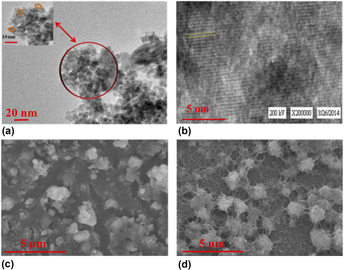Crossref Citations
This article has been cited by the following publications. This list is generated based on data provided by
Crossref.
Regan, Brian
O’Kennedy, Richard
and
Collins, David
2018.
Point-of-Care Compatibility of Ultra-Sensitive Detection Techniques for the Cardiac Biomarker Troponin I—Challenges and Potential Value.
Biosensors,
Vol. 8,
Issue. 4,
p.
114.
Chekin, Fereshteh
Vasilescu, Alina
Jijie, Roxana
Singh, Santosh K.
Kurungot, Sreekumar
Iancu, Mădălina
Badea, Gabriela
Boukherroub, Rabah
and
Szunerits, Sabine
2018.
Sensitive electrochemical detection of cardiac troponin I in serum and saliva by nitrogen-doped porous reduced graphene oxide electrode.
Sensors and Actuators B: Chemical,
Vol. 262,
Issue. ,
p.
180.
Singal, Shobhita
Srivastava, Avanish K.
Kotnala, R. K.
and
Rajesh
2018.
Single-frequency impedance analysis of biofunctionalized dendrimer-encapsulated Pt nanoparticles-modified screen-printed electrode for biomolecular detection.
Journal of Solid State Electrochemistry,
Vol. 22,
Issue. 9,
p.
2649.
Yan, Huixiang
Tang, Xiaodi
Zhu, Xudong
Zeng, Yanbo
Lu, Xing
Yin, Zhengzhi
Lu, Yixia
Yang, Yiwen
and
Li, Lei
2018.
Sandwich-type electrochemical immunosensor for highly sensitive determination of cardiac troponin I using carboxyl-terminated ionic liquid and helical carbon nanotube composite as platform and ferrocenecarboxylic acid as signal label.
Sensors and Actuators B: Chemical,
Vol. 277,
Issue. ,
p.
234.
Aydın, Elif Burcu
Aydın, Muhammet
and
Sezgintürk, Mustafa Kemal
2018.
Electrochemical immunosensor based on chitosan/conductive carbon black composite modified disposable ITO electrode: An analytical platform for p53 detection.
Biosensors and Bioelectronics,
Vol. 121,
Issue. ,
p.
80.
Farzin, Leila
Shamsipur, Mojtaba
Samandari, Leila
and
Sheibani, Shahab
2018.
Recent advances in designing nanomaterial based biointerfaces for electrochemical biosensing cardiovascular biomarkers.
Journal of Pharmaceutical and Biomedical Analysis,
Vol. 161,
Issue. ,
p.
344.
Negahdary, M.
and
Heli, H.
2019.
An electrochemical troponin I peptisensor using a triangular icicle-like gold nanostructure.
Biochemical Engineering Journal,
Vol. 151,
Issue. ,
p.
107326.
Sandil, Deepika
Sharma, Suresh C.
and
Puri, Nitin K.
2019.
Protein-functionalized WO3 nanorods–based impedimetric platform for sensitive and label-free detection of a cardiac biomarker.
Journal of Materials Research,
Vol. 34,
Issue. 08,
p.
1331.
Shen, Qihui
Liu, Man
Lü, Yang
Zhang, Dawei
Cheng, Zhenyu
Liu, Yan
Gao, Huajing
and
Jin, Zhaohui
2019.
Label-Free Electrochemical Immunosensor Based on a Functionalized Ionic Liquid and Helical Carbon Nanotubes for the Determination of Cardiac Troponin I.
ACS Omega,
Vol. 4,
Issue. 7,
p.
11888.
Lakshmanakumar, Muthaiyan
Nesakumar, Noel
Sethuraman, Swaminathan
Rajan, K. S.
Krishnan, Uma Maheswari
and
Rayappan, John Bosco Balaguru
2019.
Functionalized Graphene Quantum Dot Interfaced Electrochemical Detection of Cardiac Troponin I: An Antibody Free Approach.
Scientific Reports,
Vol. 9,
Issue. 1,
Kumar, Suveen
Panwar, Shweta
Kumar, Saurabh
Augustine, Shine
and
Malhotra, Bansi D.
2019.
Biofunctionalized Nanostructured Yttria Modified Non-Invasive Impedometric Biosensor for Efficient Detection of Oral Cancer.
Nanomaterials,
Vol. 9,
Issue. 9,
p.
1190.
Shen, Guangyu
and
Shen, Youming
2019.
Label-Free Electrochemical Immunosensor Based on β-Cyclodextrin-Functionalized Helical Carbon Nanotube and Ionic Liquid Containing Ferrocene and Aldehyde Groups.
ACS Omega,
Vol. 4,
Issue. 23,
p.
20252.
Taniselass, S.
Arshad, M.K. Md
and
Gopinath, Subash C.B.
2019.
Graphene-based electrochemical biosensors for monitoring noncommunicable disease biomarkers.
Biosensors and Bioelectronics,
Vol. 130,
Issue. ,
p.
276.
Gupta, Niharika
Renugopalakrishnan, Venkatesan
Liepmann, Dorian
Paulmurugan, Ramasamy
and
Malhotra, Bansi D.
2019.
Cell-based biosensors: Recent trends, challenges and future perspectives.
Biosensors and Bioelectronics,
Vol. 141,
Issue. ,
p.
111435.
Chauhan, Dipti
Pooja
Nirbhaya, Vishakha
Srivastava, Chandra Mohan
Chandra, Ramesh
and
Kumar, Suveen
2020.
Nanostructured transition metal chalcogenide embedded on reduced graphene oxide based highly efficient biosensor for cardiovascular disease detection.
Microchemical Journal,
Vol. 155,
Issue. ,
p.
104697.
Dhara, Keerthy
and
Mahapatra, Debiprosad Roy
2020.
Review on electrochemical sensing strategies for C-reactive protein and cardiac troponin I detection.
Microchemical Journal,
Vol. 156,
Issue. ,
p.
104857.
Zhang, Kailian
Zhou, Man
Yu, Changlin
Yang, Kai
Li, Xiaoxiao
Dai, Wenxin
Guan, Jie
Shu, Qing
and
Huang, Weiya
2020.
Construction of S-scheme g-C3N4/ZrO2 heterostructures for enhancing photocatalytic disposals of pollutants and electrocatalytic hydrogen evolution.
Dyes and Pigments,
Vol. 180,
Issue. ,
p.
108525.
Chaudhary, Navneet
Yadav, Amit K.
Sharma, Jai Gopal
and
Solanki, Pratima R.
2021.
Designing and characterization of a highly sensitive and selective biosensing platform for ciprofloxacin detection utilizing lanthanum oxide nanoparticles.
Journal of Environmental Chemical Engineering,
Vol. 9,
Issue. 6,
p.
106771.
Feng, Sinuo
Yan, Mengxia
Xue, Yu
Huang, Jianshe
and
Yang, Xiurong
2021.
Electrochemical Immunosensor for Cardiac Troponin I Detection Based on Covalent Organic Framework and Enzyme-Catalyzed Signal Amplification.
Analytical Chemistry,
Vol. 93,
Issue. 40,
p.
13572.
Subbaiah, G. Bala
Ratnam, K. Venkata
Janardhan, S.
Shiprath, K.
Manjunatha, H.
Ramesha, M.
Prasad, N. V. Krishna
Ramesh, S.
and
Babu, T. Anil
2021.
Metal and Metal Oxide Based Advanced Ceramics for Electrochemical Biosensors-A Short Review.
Frontiers in Materials,
Vol. 8,
Issue. ,
